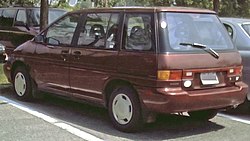The Nissan Prairie, introduced in Japan in 1981 and Europe in 1982, was a car from Japanese manufacturer Nissan. It was also known as the Multi in Canada and the Stanza Wagon in the United States.
The Prairie was one of the first "crossover" cars, resembling a tall station wagon / estate with the addition of sliding side doors. It was commonly ordered with five seats, though seven were available. The size of one of today's compact SUVs, it was amongst the forefront of the trend for multi-purpose vehicles which had rarely been seen since the the Fiat 600 Multipla of the 1950s. The closest contemporary competitor was the Mitsubishi Chariot — other options for cars (as opposed to minibuses / minivans) with more than five seats were limited to large estates such as the Citroën CX family model, off-road vehicles such as the Land Rover Defender, and oddities such as the Talbot Matra Rancho which had extra rear-facing child seats.
The concept was inspired by the Lancia Megagamma show car from Giorgetto Giugiaro and ItalDesign, shown in 1979. Nissan, at the time, was very keen to have "European" styling for its cars.
It was originally launched with a 1.5 L I4 engine and a 1.8 L engine followed later in the car's life, as did a four wheel drive version.
The first generation Prairies, while innovative, had undesirable body characteristics when driven hard, due to the removal of the B-pillar.
Prairie around the world
North America
Nissan Multi
| Nissan Multi / Nissan Stanza | |
|---|---|
 | |
| Manufacturer | Nissan |
| Production | 1986–1988 |
| Successor | Nissan Axxess |
| Class | Compact MPV |
| Body style(s) | 4-door minivan |
| Engine(s) | 2.0 L ca20E I4 |
| Transmission(s) | 4-Speed Automatic Overdrive 5-Speed Manual |
| Wheelbase | 102.80 in (2611 mm) |
| Length | 4.37 m (171.9 in) |
| Width | 1.69 m (66.5 in) |
| Height | 1.64 m (64.6 in) |
| Related | Nissan Stanza |
The 1986 until 1988, Nissan Multi (in Canada) or Stanza Wagon (in the United States) was equipped with a 2-litre in-line 4 cylinder engine, with available manual or automatic transmissions. Available with front wheel drive or four wheel drive, the vehicle had rear passenger sliding doors on both sides of the vehicle, and a folding rear seat, designed to increase the carrying capacity of the passenger compartment. The rear tailgate opened upwards as one complete unit, in a similar fashion to a hatchback or station wagon.
Nissan Prairie Mark 2
| Nissan Prairie | |
|---|---|
 | |
| Manufacturer | Nissan |
| Also called | Nissan Axxess |
| Production | 1990–1995 |
| Predecessor | Nissan Multi |
| Successor | Nissan Quest, Nissan Serena Nissan Liberty |
| Class | Compact MPV |
| Body style(s) | 4-door minivan |
| Engine(s) | 2.4 L KA24E I4 |
| Transmission(s) | 4-Speed Automatic Overdrive 5-Speed Manual |
| Wheelbase | 102.80 in (2611 mm) |
| Length | 4.37 m (171.9 in) |
| Width | 1.69 m (66.5 in) |
| Height | 1.64 m (64.6 in) |
| Related | Nissan Stanza |
The second generation of the Prairie was called the Nissan Axxess when sold in North America. The vehicle sold for six years (1990–95) in Canada, and in 1990 only in the United States.
Sales
The Axxess was not the export success that Nissan had expected. As such, Nissan would not market another Minivan until the Nissan Quest in 1993 — or until the Nissan Serena in the case of the European market. Even then, the first generation of the Quest was manufactured by Ford Motor Company in the United States.





![Validate my RSS feed [Valid RSS]](valid-rss-rogers.png)















































































ไม่มีความคิดเห็น:
แสดงความคิดเห็น